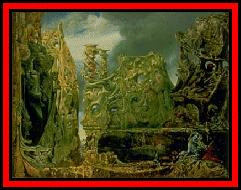| (Divide
the class into teams. Suggest that each team
member take on one specific area of modern art to
focus on. They should share their findings with
their team mates, stressing the most important
items. The teams should be given time before each
round to share the facts they discovered refresh
their memories, and plan strategies.) There
are 3 rounds before the final. The first two are
qualifying rounds. The total score of these two
rounds combined determines which three teams go
into the semi-finals. The top two scores of the
3rd round go on to the final round.
Round 1: Draw me a
picture - Each team member will
create a drawing using colored markers. The
drawing is to be in the style of Piet Mondrian.
The quality of their work counts as well.
They must then be able to identify what art
movement his work is representative of.
Round 2: Match this
- The teams will be
given the name of 5 art movements and shown
examples of each in random order. Each team must
match the example to the correct form. They will
then be shown the name and/or image of the
artists who painted the examples. They must match
these correctly.
(Teachers may use
whatever prints or slides they have available.
Samples from most of the links can be copied and
pasted in Power Point or similar programs for
viewing. Another option is to copy and paste the
samples on Microsoft word and run off enough
copies for each team. The sample and artist
choices are up to the instructor but should
appear in at least one of the links suggested.)
Round 3: 5+5 in time - The remaining
3 teams will be given 5 movements and the name of
5 artists. The movements and artists may not
necessarily be linked together. The team must be
able to list 5 facts about each. This round is
timed. The two teams with the most correct
answers before the clock runs out go on to the
final round.
(Teachers may wish to
run the students through the practice round to
get an idea of how long it should take students
to come up with answers. Use this as a gage to
set your time for this round.)
Round 4: Winner takes
all - Each team will form
two lines. The first person in each will flip a
coin to see who goes first. The instructor will
read questions from a list. If you answer the
question correctly you will go to the end of the
line. If you miss a question you will sit
down and be out of the challenge. The team who
still has members standing when the other
doesn't, wins, providing they answered the last
question correctly during the last go around. If
there are only one remaining on each team and
they are elliminated at the same time, they
continue on until one misses and the other
answers correctly.
(Teachers must do some
research of their own to come up with questions
for the final round. It is suggested that you
have at least 5 questions for every team
member on both teams. Keep track of the
ones missed. As you wind down you can always go
back to these if you run out of fresh questions.
Caution students not to shout out answers as they
may forfeit that go around or give an answer away
to their opponent.)
|











